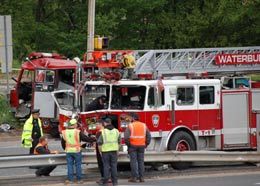| Editor’s note: Fire/EMS Safety, Health and Survival Week runs June 22-28. Check out FireRescue1’s special section for more articles, resources and tips. |
 Photo Kevin Czarzasty |
Fifteen firefighters were killed in 2006 alone responding to and returning from the scene and countless others were injured. Volunteers have gained a bad rep for responding, both in our personal and emergency vehicles. It’s time we — and career firefighters — changed that to save not only the lives we are responsible for but our own, too.
We spend considerable amounts of time training on how to be safe on the fireground, maintaining our skills, and developing rapid intervention teams, but then we neglect the most dangerous and common thing we do: driving to and from the scene.
To enable us to become safer, the IAFC has identified three areas for improvement:
- Always buckle up
- Always stop at red lights and stop signs
- Always drive at speed limits and defensively
These three points may seem to be common sense, but they are often ignored. While using our lights and sirens may allow us to break motor vehicle laws, it must be done with due regard for safety — and our safety should always come first.
Firefighters should know better. We are often the ones that have to pick up people who were ejected from their vehicle, but we still do not all wear our seat belts. I have heard every excuse for this, from them being uncomfortable to hampering the ability to put an airpack on. Seat belts are not only required by law in most states, but are proven to save lives. There is no excuse that is valid when it comes to our own safety. There is even a new trend to mount all airpacks in an outside compartment so that members wear their seat belt.
Your policy should state that all members are required to wear their seat belt at all times in any moving vehicle, no matter whether it’s their personal vehicle or a piece of fire apparatus. Most of us have come a long way from riding on the back of the apparatus; it’s now time we take the next step in personal safety and stay belted at all times.
Intersections are often the most common location of emergency vehicle crashes, yet we continue to blow through stop signs and red lights like they do not exist. What is even more dangerous is when our members with their “courtesy lights” on their personal vehicles go through controlled intersections, a dangerous and illegal action.
Controlling an intersection includes coming to a complete stop and making eye contact with each of the drivers there to assure they see your apparatus and have also come to a complete stop. This may seem unnatural to some, but it is a safety habit that we all need to embrace. The officer should not only enforce your department’s policy to come to a complete stop, but also provide a second set of eyes.
The final section of the IAFC’s recommendations is to drive defensively and observe speed limits. Many departments have adopted a policy of no more than 10 miles over the speed limit and this is often a good compromise. Ten miles over the speed limit may be less than what we are used to driving in our personal vehicle to get a loaf of bread. But the difference between going grocery shopping and responding to an emergency is not only the apparatus you are in, but also the reactions of the public to that apparatus.
Anyone who has driven a fire truck in emergency response mode knows that the public will always do weird things such as pull in front of you and stop, and that stopping a fire truck is much different then your Honda Civic.
Everyone wants to play with the lights and sirens, but driving recklessly endangers everyone’s lives. If you crash on the way to the scene you will do no good to the public you are trying to serve. While I did have that period early on when I was much younger and loved to drive fast, I now realize that you are just rolling the dice and the odds are not good. The officer needs to take an active roll in ensuring that the apparatus is operated in a safe manner, including speed. Newer apparatus should include a speed monitor on the officer’s side, and every driver should complete an emergency vehicles operator course (EVOC).
One last thing on driving safely… The same policies should be in place for personal vehicles as apparatus including training, seat belts, speed, and intersections. Every member should have to complete an EVOC program or the like, even before responding in their personal vehicle with a courtesy light. What is amazing is that departments will not allow young members or those without training to drive their apparatus in emergency mode, yet turn a blind eye to how we respond in our personal vehicle.
We tell our members not to break the law, but then see them coming around the corner on two wheels. This double standard cannot exist in a professional volunteer department. It is time we make sure that we are safe responding both to and from emergency and non-emergency calls.











